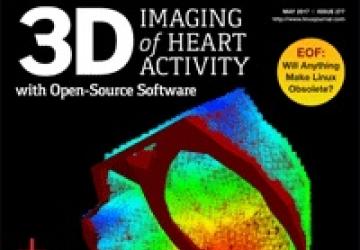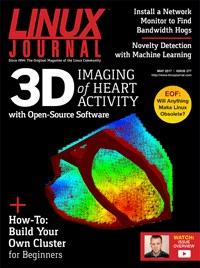Linux Journal May 2017


Doing Big Things
I bought a book a few years back titled, Installing Linux on a Dead Badger by Lucy Snyder. When I see that book on my bookshelf, it still makes me chuckle. And although a dead badger is certainly not a common operating system platform, it seems like Linux continues to end up on more and more hardware every year. Often those devices are tiny, but sometimes those devices are giant clusters of computers that crunch trillions of numbers a second. And of course, some of the tiniest installations end up having the biggest effects (smartphones, for instance). This month's issue is a reminder of just how well our favorite operating system has infiltrated our lives.
We start with Reuven M. Lerner continuing his theme of computer-based learning. Many of you probably remember the Sesame Street game Grover played with viewers called "One of These Things Is Not Like the Others". In a similar vein, Reuven shows how you can teach a bit of software how to play that game as it pertains to sets of data. Rather than just chopping off the highs and lows in a set of data, computer learning can determine what data is actually out of place.
Dave Taylor follows with some really awesome scripting. If you've ever spent time mindlessly browsing YouTube, you've probably liked a video so much at one point that you wanted a local copy. Or, perhaps you've wished you could strip the audio off a YouTube video and play it on your sound system. Dave describes a really cool tool for extracting audio and video from YouTube URLs. Google might not be thrilled at the idea of downloading copies of videos, but once again, Linux saves the day.
Speaking of saving the day, Kyle Rankin continues his series on systems administration. This month, he helps define the various levels and titles of administrative abilities. Ever wonder if you qualify as a junior systems administrator or a senior systems administrator? Kyle helps explain what the various titles mean, which is invaluable if you're applying for a job or planning to hire more help. Even if your interests don't lie in administration, the information is critical for anyone in IT to understand.
I did a little bit of investigating this month. Specifically, I investigated my network trying to track down some rogue traffic on my router. I learned a lot along the way, and in the end, I had a face-palm moment. Nevertheless, I figured all the network monitoring and investigative knowledge made it worthwhile. If you're uncertain what is happening on your local network, I encourage you to read my column.
Jacques De Hooge describes another way Linux and open source can help you determine what is going on, specifically what's going on in your chest. Using various open-source tools, along with a few proprietary ones, Jacques tells how Linux helps create 3D models of the heart for diagnoses. It's a perfect example of Linux quietly making the world go round, and it's also really cool to learn about!
We finish off the issue with the first part of a series on building a computer cluster using Linux. Nathan R. Vance, Michael L. Poublon and William F. Polik join forces to teach how to create an appropriate cluster from beginning to end. Whether you want to build your own cluster, or just want to learn about the technology, it's an awesome series that we're starting this month.
We also have the normal collection of Linux Journal goodies, including tech tips, new product announcements and UpFront oddities from around the internet. Whether you love Linux because of all the tiny places in can be installed or think it's awesome that Linux powers the internet, this issue should tickle your fancy all the same.
Available to Subscribers: May 1










